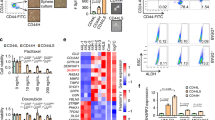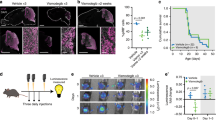Abstract
Self-renewal is considered as a common property of stem cells. Dysregulation of stem cell self-renewal is likely a requirement for the development of cancer. Hiwi, the human Piwi gene, encodes a protein responsible for stem cell self-renewal. In this study, we investigated the expression of Hiwi at the RNA level by real-time quantitative PCR in 65 primary soft-tissue sarcomas (STS) and ascertained its impact on prognosis for STS patients. In a multivariate Cox's proportional hazards regression model, we found that an increased expression of Hiwi mRNA is a significant negative prognostic factor for patients with STS (P=0.017; relative risk 4.6, 95% confidence interval (CI) 1.3–16.1) compared to medium expression of Hiwi transcript. However, a low expression of Hiwi transcript is correlated with a 2.4-fold (CI 0.7–8.0) increased risk, but this effect was not significant (P=0.17). Altogether, high-level expression of Hiwi mRNA identifies STS patients at high risk of tumour-related death. This is the first report showing a correlation between expression of a gene involved in stem cell self-renewal and prognosis of cancer patients.
This is a preview of subscription content, access via your institution
Access options
Subscribe to this journal
Receive 50 print issues and online access
$259.00 per year
only $5.18 per issue
Buy this article
- Purchase on Springer Link
- Instant access to full article PDF
Prices may be subject to local taxes which are calculated during checkout

Similar content being viewed by others
Abbreviations
- ag:
-
attogram
- CI:
-
confidence interval
- RR:
-
relative risk
- STS:
-
soft-tissue sarcoma(s)
References
Aravin A, Gaidatzis D, Pfeffer S, Lagos-Quintana M, Landgraf P, Iovino N et al. (2006). A novel class of small RNAs bind to MILI protein in mouse testes. Nature 442: 203–207.
Cerutti L, Mian N, Bateman A . (2000). Domains in gene silencing and cell differentiation proteins: the novel PAZ domain and redefinition of the Piwi domain. Trends Biochem Sci 25: 481–482.
Cox DN, Chao A, Lin H . (2000). Piwi encodes a nucleoplasmic factor whose activity modulates the number and division rate of germline stem cells. Development 127: 503–514.
Fetzer CP, Hogan DJ, Lipps HJ . (2002). A PIWI homolog is one of the proteins expressed exclusively during macronuclear development in the ciliate Stylonychia lemnae. Nucleic Acids Res 30: 4380–4386.
Girard A, Sachidanandam R, Hannon GJ, Carmell MA . (2006). A germline-specific class of small RNAs binds mammalian Piwi proteins. Nature 442: 199–202.
Lingel A, Sattler M . (2005). Novel modes of protein–RNA recognition in the RNAi pathway. Curr Opin Struct Biol 15: 107–115.
Liu X, Sun Y, Guo J, Ma H, Li J, Dong B et al. (2006). Expression of hiwi gene in human gastric cancer was associated with proliferation of cancer cells. Int J Cancer 118: 1922–1929.
Parker JS, Roe SM, Barford D . (2004). Crystal structure of a PIWI protein suggests mechanisms for siRNA recognition and slicer activity. EMBO J 23: 4727–4737.
Qiao D, Zeeman AM, Deng W, Looijenga LH, Lin H . (2002). Molecular characterization of hiwi, a human member of the piwi gene family whose overexpression is correlated to seminomas. Oncogene 21: 3988–3999.
Sharma AK, Nelson MC, Brandt JE, Wessman M, Mahmud N, Weller KP et al. (2001). Human CD34(+) stem cells express the hiwi gene, a human homologue of the Drosophila gene piwi. Blood 97: 426–434.
Soltysova A, Altanerova V, Altaner C . (2005). Cancer stem cells. Neoplasma 52: 435–440.
van Unnik JA . (1995). Classification and grading of soft-tissue sarcomas. Hematol Oncol Clin N Am 9: 677–700.
Wittekind Ch, Wagner G (eds). (1997). UICC TNM – Klassifikation Maligner Tumoren 5th edn. Springer: Berlin, Heidelberg, New York.
Würl P, Kappler M, Meye A, Bartel F, Köhler T, Lautenschläger C et al. (2002). Co-expression of survivin and TERT and risk of tumour-related death in patients with soft-tissue sarcoma. Lancet 359: 943–945.
Acknowledgements
This work was supported by a grant from the Deutsche Forschungsgemeinschaft Project No. TA 145/8-19 and a grant from the Deutsche Krebshilfe Project No.10-2130-Ta2. We thank Deanna Naeve and Dr Clayton Naeve from St Jude Children's Research Hospital, Memphis, TN, USA for continuous support and helpful discussions. The funding source had no role in study design, data collection, data analysis, data interpretation or writing of the report.
Author information
Authors and Affiliations
Corresponding author
Rights and permissions
About this article
Cite this article
Taubert, H., Greither, T., Kaushal, D. et al. Expression of the stem cell self-renewal gene Hiwi and risk of tumour-related death in patients with soft-tissue sarcoma. Oncogene 26, 1098–1100 (2007). https://doi.org/10.1038/sj.onc.1209880
Received:
Revised:
Accepted:
Published:
Issue Date:
DOI: https://doi.org/10.1038/sj.onc.1209880
Keywords
This article is cited by
-
Co-overexpression of self-renewal markers SALL4 and HIWI is correlated with depth of tumor invasion and metastasis in colorectal cancer
Egyptian Journal of Medical Human Genetics (2022)
-
MRI detection of the malignant transformation of stem cells through reporter gene expression driven by a tumor-specific promoter
Stem Cell Research & Therapy (2021)
-
MAEL as a diagnostic marker for the early detection of esophageal squamous cell carcinoma
Diagnostic Pathology (2021)
-
Epigenetic roles of PIWI proteins and piRNAs in colorectal cancer
Cancer Cell International (2021)
-
Estrogen-ERα signaling and DNA hypomethylation co-regulate expression of stem cell protein PIWIL1 in ERα-positive endometrial cancer cells
Cell Communication and Signaling (2020)



